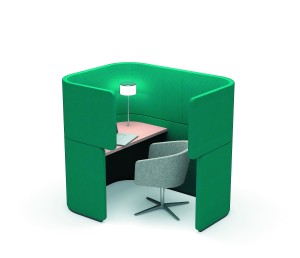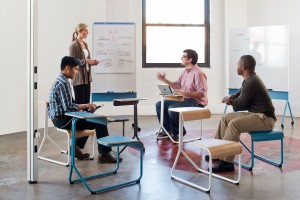
While this workstation might look like a cubicle, don’t be fooled. The Docklands line by Bene was designed to offer private workspace in an open office plan. Workers duck in when they need to concentrate and go back into the crowd when they’re ready to collaborate.
Virtually no one has been able to escape the affects of the Great Recession; it’s hit everything from jobs to retail sales to manufacturing.
As businesses have downsized so have their furniture needs, which means in recent years office furniture manufacturers scaled back production. What’s more, the fluctuating price of raw materials like wool and steel have made it tough for manufacturers to make predictions about spending and cost control, which has further hurt their bottom line, according to an article on BizJournals.com.
Manufacturers saw sales decline an average of 6.5 percent in the five years leading up to 2012 according to a report on office furniture industry by IBISWorld Inc.
The downward trend could be shifting. As the U.S. economy limps toward recovery and companies begin hiring again, IBISWorld predicts that the office furniture manufacturing will see growth as well. All those new employees need desks, chairs and other office equipment, after all. Experts forecast that by 2017, revenue will increase at an average annual rate of 2.2 percent according to BizJournals.com.
Factors beyond hiring could contribute to the rebound in office furniture manufacturing, like the boom in open space offices designed to embrace collaboration.
Office Furniture Manufacturers Re-envision the Office
One of the biggest buzzwords in office design in recent years has been “collaboration” as companies work to create spaces that promote more teamwork and spur-of-the-moment brainstorming while also helping to save money on square footage and large furniture.
In recent years, office furniture giant Herman Miller has lead the charge tearing down the same cubicle walls it’s credited for creating back in the 1960s.
Businesses like Microsoft and Campbells Soup Co. have turned to consultants from Herman Miller to track how to use office space more effectively and efficiently and are ditching closed cubicles in favor of more collaborative open spaces and large conference rooms in favor of smaller “focus rooms” designed for two to four people, according to an article on The Leader Board.
In addition, businesses hoping to attract young talent are finding that they need to adapt the work environment to a generation of workers who network everywhere from Starbucks to the library to their living room. There’s an expectation that the office be a more fluid environment where employees can enjoy connectivity and collaboration anywhere rather than being tethered to a cubicle.
As a result, more offices are being designed to encourage “random encounters” and include ad-hoc work areas that can pop up as needed. Giant conference tables in a space-wasting meeting room are giving way to specialized furniture designed to be multi-functional, connected and lightweight so that it can be moved easily.

Knoll’s Toboggan chairs take you back to your days in grammar school, but they are the manufacturer’s solution for easy open-office meeting space.
Knoll recently designed a desk/chair hybrid called the Toboggan that provides a seat and a work surface to lay a smartphone or tablet on. To keep all those devices charged, the furniture manufacturer also created a stainless steel pole full of outlets along with portable tables with outlets, too. They’ve also created rolling whiteboards for use in quick brainstorming sessions.
According to an article on Officing Today, Bene, another furniture designer, recently created a line called “Docklands” meant to reflect the trend in flexible working and foster collaboration while allowing for privacy. They might look like the cubicles of old, but these hubs are intended for use in open-plan offices when employees need a quiet space for some “head down” work. They’re not assigned desks, but rather shared among employees or hot deskers, kind of like a study carrel at the library.
More Reasons Companies are Buying Office Furniture
Beyond re-envisioning the way an office is used to improve collaboration and productivity, there are other factors that could contribute to a rebound in furniture manufacturing.
With growing concerns about workplace health and safety, companies are increasingly investing in new ergonomic seating, which typically come with a higher price tag according to BizJournals.com. Plus, with studies highlighting the adverse affects of sitting at a desk all day, more offices are adopting standing desks or even treadmill or cycling desks for their employees.
Of course, on the flip side is the fact that companies are also needing to accommodate the growing size of employees by purchasing chairs with wider seats that can support more weight.
And finally, while the rise in telecommuting has reduced the amount of workspace companies need to provide for employees, businesses will no doubt be watching Yahoo! closely after CEO Marissa Mayer famously asked workers to return to the office. If the search engine finds success with the controversial move, who knows if more businesses might follow suit?
If it’s time for your business to re-think office design or update aging furniture, check in with Arnolds. We offer a wide range of used and refurbished office furniture to accommodate all of your open office needs.





